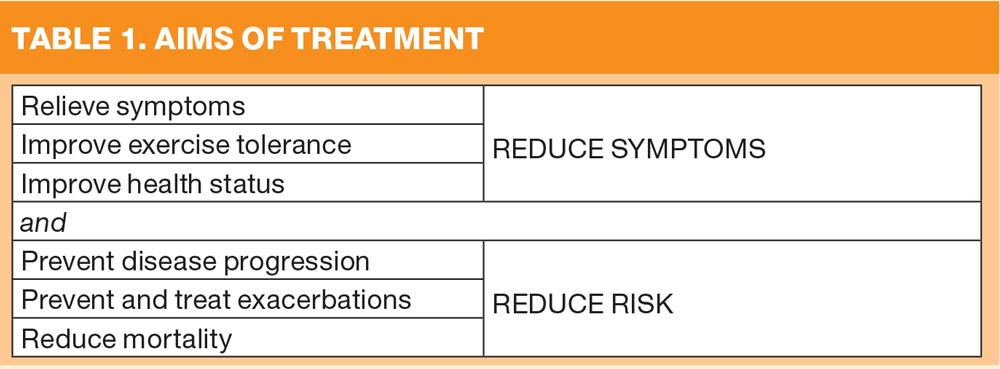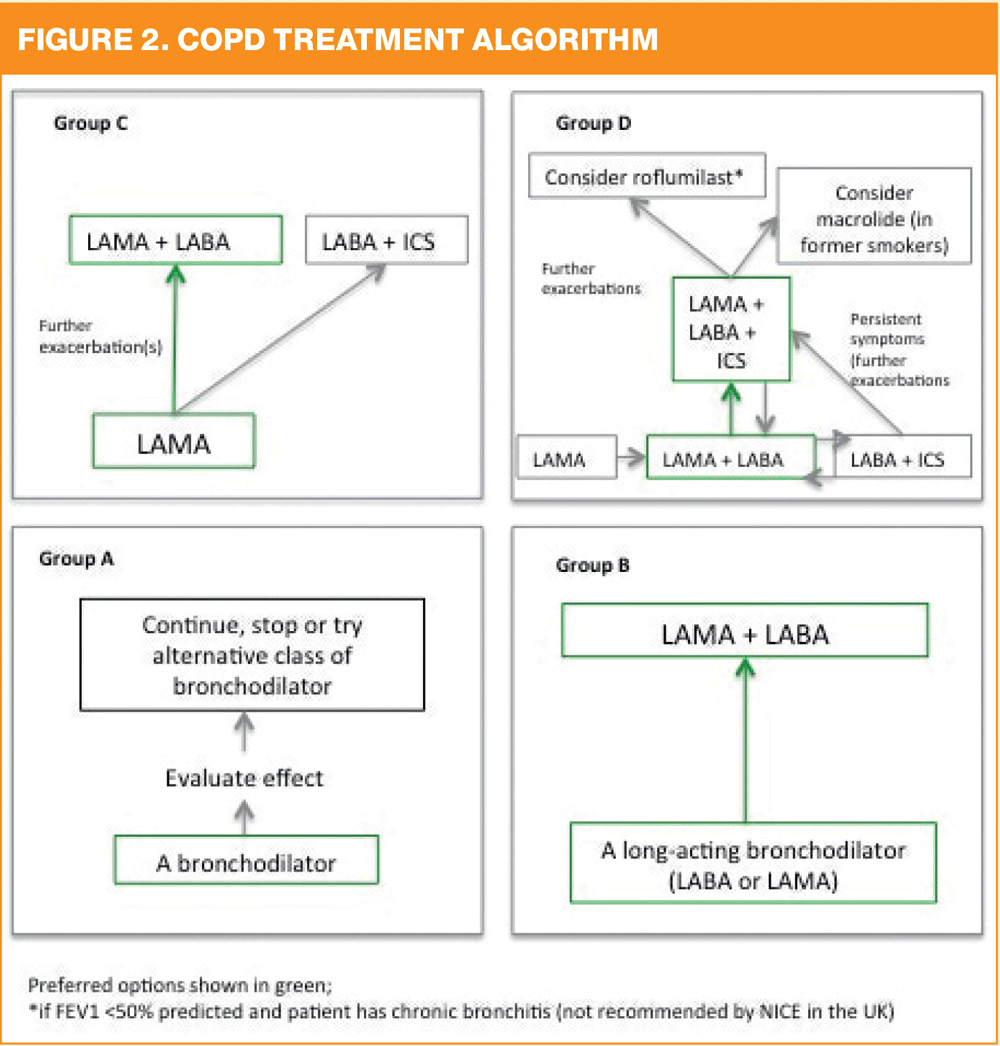
COPD: GOLD 2017
While The Global Initiative for Chronic Obstructive Lung Disease (GOLD) regularly updates its guideline, this is the first major revision in six years, and much has changed
The latest guideline from GOLD attaches greater significance to symptoms and future risk of exacerbations when mapping out treatment options for people with COPD.
The ABCD assessment tool has been updated to use respiratory symptoms and exacerbations alone to assign ABCD categories, which are used to guide drug choices.
The new version also places more emphasis on a personalised approach to treatment of the individual, and introduces strategies for escalation and de-escalation of drug therapy as the patient’s symptoms improve or deteriorate.
Improvement in symptoms and health status has always been a GOLD treatment objective, but now that there are simple, reliable questionnaires readily available in any clinical setting, it is much easier to measure the impact of a patient’s symptoms, and take a new approach to management – ‘one that matches assessment to treatment objectives… and the patient’s therapy more closely to his or her needs.’
The guideline also adds assessment and regular evaluation of inhaler technique in an attempt to improve outcomes, and offers new evidence for self-management, pulmonary rehabilitation, integrated care and palliative care.
Not least, GOLD has also refined its definition of COPD, to include the impact of respiratory symptoms and the role of lung tissue and airway abnormalities (host factors) as well as smoking and other environmental exposures in the development of the condition.
KEY POINTS
- Smoking cessation remains key: pharmacotherapy and nicotine replacement increase long-term quit rates, but the role of e-cigarettes is still uncertain.
- Drug therapy can reduce symptoms, reduce the frequency and severity of exacerbations, and improve health status and exercise tolerance.
- Flu vaccination decreases the incidence of lower respiratory tract infections.
- Pulmonary rehabilitation improves symptoms, quality of life and physical and emotional participation in everyday activities.
DEFINITION
COPD is a common, preventable and treatable disease characterised by persistent respiratory symptoms and airflow limitation due to airway and/or alveolar abnormalities usually caused by significant exposure to noxious particles or gases. Cigarette smoking is the most studied, but not the only, risk factor. Others include occupational exposure to dust, chemicals and fumes, and indoor air pollution (e.g. cooking over open fires). Asthma may also be a risk factor for chronic airflow limitation and COPD. Host factors (genetic factors, congenital/development abnormalities) also increase risk.
DIAGNOSIS
Consider COPD and perform spirometry if any of the following indicators are present in a person over age 40.
- Dyspnoea – progressive, worse with exercise, persistent
- Chronic cough – may be intermittent/unproductive
- Chronic sputum production
- Recurrent lower respiratory tract infections
- History of risk factors
Diagnosis must be confirmed by spirometry, performed by trained, quality assured technicians, using techniques that meet published standards, with regularly calibrated spirometers.
FEV1/FVC < 0.70 confirms COPD in people with characteristic symptoms and significant exposure to risk factors. In patients with FEV1/FVC <0.70:
GOLD 1: Mild FEV1 ≥ 80% predicted
GOLD 2: Moderate 50% ≤ FEV1 <80% predicted
GOLD 3: Severe 30% ≤ FEV1 <50% predicted
GOLD 4: Very severe FEV1 < 30% predicted.
ASSESSMENT OF SYMPTOMS
There is only a weak correlation between FEV1, symptoms and health status so formal assessment of symptoms is required. Use the modified MRC dyspnoea scale (mMRC) to assess breathlessness and the COPD Assessment Test (CAT) to assess health status impairment. Also assess exacerbation risk: the best predictor of frequent exacerbations (two or more per year) is a history of previous exacerbations needing treatment. Also assess co-morbidities e.g. cardiovascular disease.
NEW COPD ASSESSMENT TOOL
The impact of COPD on the individual patient combines symptomatic assessment with their spirometric classification and/or risk of exacerbations. The ABCD assessment tool from the 2011 GOLD guidance has been updated to use respiratory symptoms and exacerbations alone to assign ABCD categories. (Figure 1) Spirometry remains essential for diagnosis and prognosis, but for many patients with COPD, treatment decisions will be based solely on their ABCD category. In the new assessment scheme, patients should undergo:
- Spirometry to determine airflow limitation, and
- Assessment of dyspnoea (mMRC) or symptoms (CAT), and
- Exacerbation history should be recorded
Where there is a significant discrepancy between the degree of airflow limitation and the patient’s perception of symptoms, further investigations are needed.
TREATMENT
- Drug choices should be individualised and guided by:
- Severity of symptoms
- Risk of exacerbations
- Side-effects
- Co-morbidities
- Availability and cost
- Patient response, preference and
- ability to use the inhaler device(s)
- Inhaler technique needs to be assessed regularly
Group A patients should be offered a short- or long-acting bronchodilator.
Group B patients: initial therapy should be long-acting bronchodilator, which are more effective than short-acting bronchodilators used as needed.
Patients with persistent breathless on monotherapy should be prescribed two bronchodilators (long-acting beta2-agonist [LABA] and long-acting antimuscarinic agent [LAMA])
Group C: initial therapy should be a single long-acting bronchodilator. GOLD recommends a LAMA over LABA for this group.
Patients with persistent exacerbations may benefit from the addition of a second bronchodilator (LABA/LAMA), or LABA plus inhaled corticosteroid (ICS). As ICS increases the risk of pneumonia in some patients, GOLD recommends LABA/LAMA.
Group D: Start therapy with LABA/LAMA combination.
In patients with history or symptoms suggesting asthma-COPD overlap or high eosinophil counts, consider LABA/ICS.
Patients who develop further exacerbations on LABA/LAMA escalate to LABA/LAMA/ICS.
Further options
For group D patients who continue to have exacerbations on LABA/LAMA/ICS consider:
- Roflumilast for patients with FEV1 <50% predicted, chronic bronchitis and at least one hospital admission for exacerbation in previous year (although this does not have NICE approval in the UK)
- Add a macrolide: the best evidence is for azithromycin. Be aware of potential for antimicrobial resistance
- Stopping ICS: lack of efficacy, risk of adverse effects and evidence for no significant harm from withdrawing ICS support this recommendation.
Education and self-management
These should be a major component of care. Clinicians should go beyond simple education/advice-giving to help patients to:
- Learn and adopt sustainable self-management skills
- Address behavioural risk factors
- Monitor and manage the signs and symptoms of their condition
- Adhere to treatment
MONITORING AND FOLLOW-UP
Routine follow-up of COPD patients is essential. Lung function may deteriorate over time even with best care. Symptoms, exacerbations and objective measures of airflow limitation should be monitored to decide when to adjust treatment as the disease progresses. Monitoring should also include:
- Dosages of prescribed drugs
- Adherence
- Inhaler technique
- Effectiveness of current regime
- Side effects
Also monitor for development of conditions including heart failure, ischemic heart disease, arrhythmias, osteoporosis (from prolonged use of ICS), depression and/or anxiety and lung cancer (more common in patients with COPD).
MANAGEMENT OF EXACERBATIONS
Most exacerbations (80%) can be managed without hospital admission.
- Initial treatment is with short-acting B2-agonists +/- short-acting anticholinergics
- Oral corticosteroids can improve lung function, oxygenation and shorten recovery time
- Antibiotics, when indicated, can shorten recovery time, reduce the risk of early relapse, treatment failure (and length of hospital stay)
- Indications for antibiotics include: increase in dyspnea, sputum volume, and sputum purulence or need for mechanical ventilation.
- Choice of antibiotic should be guided by local bacterial resistance patterns
- Patients who have been admitted to hospital for treatment of an exacerbation should be followed up soon after discharge to review discharge therapy, make any changes needed to ongoing treatment, and initiate measures to prevent further exacerbations, e.g. provide management plan, reassess inhaler technique, evaluate ability to cope in usual environment. (Table 2)
CONCLUSION
Much has changed in the 6 years since the last major update of the GOLD report. This major revision builds on previous recommendations and incorporates new knowledge. However, the primary objectives of the original report remain unchanged – to relieve and reduce the impact of symptoms, and to reduce the risk of exacerbations that may affect the patient in future. The new management approach moves COPD treatment more closely towards individualised, more personal medicine. •
REFERENCE
Global Initiative for Chronic Obstructive Lung Disease. GOLD 2017 Report. http://goldcopd.org/gold-2017-global-strategy-diagnosis-management-prevention-copd/
Related guidelines
View all Guidelines



